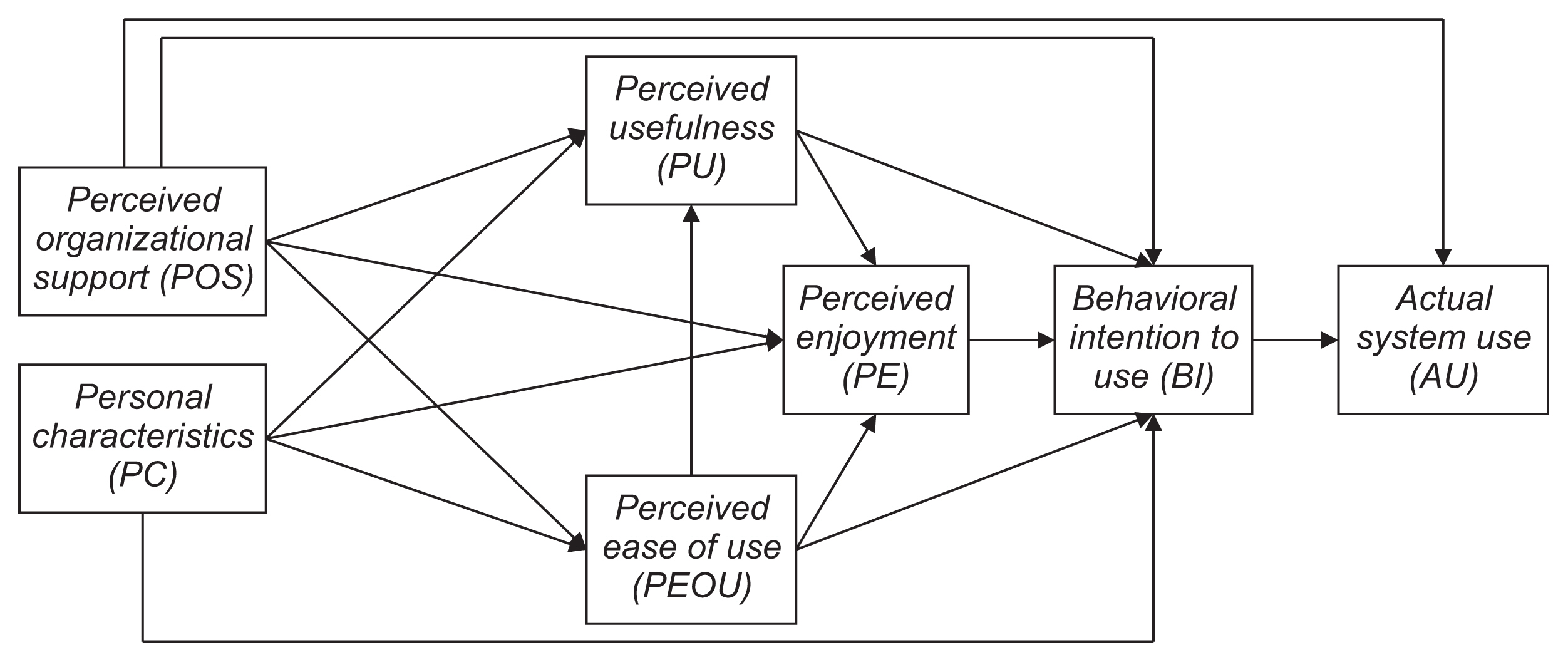Healthc Inform Res.
2021 Apr;27(2):127-136. 10.4258/hir.2021.27.2.127.
Acceptance Model of a Mandatory Health Information System in Indonesia
- Affiliations
-
- 1Department of Midwifery, Poltekkes Kemenkes Surabaya, Surabaya, Indonesia
- 2Faculty of Public Health, Universitas Airlangga, Surabaya, Indonesia
- 3Department of Nursing, Poltekkes Kemenkes Kendari, Kendari, Indonesia
- KMID: 2515915
- DOI: http://doi.org/10.4258/hir.2021.27.2.127
Abstract
Objectives
The purpose of this study was to develop a model of acceptance of the Mother and Child Health Information System in the Ngawi Regency Health Office, Indonesia based on the technology acceptance model, by integrating organizational support and personal characteristics as external variables and enjoyment as an intervening variable.
Methods
The design of this study was cross-sectional. The subjects of this study were 217 village midwives who had operated the Maternal and Child Health Information System in the Ngawi Regency Health Office, Indonesia. The variables studied were perceived organizational support, personal characteristics, perceived ease of use, perceived usefulness, perceived enjoyment, behavioral intention, and actual system use. Data were collected through questionnaires, and then analyzed using structural equation modeling.
Results
In terms of the total effect, the most meaningful factor affecting actual system use was perceived organizational support (0.766), followed in descending order by behavioral intention to use (0.344), perceived enjoyment (0.238), personal characteristics (0.118), perceived usefulness (0.054), and perceived ease of use (0.048).
Conclusions
In the acceptance model of the Mother and Child Health Information System in Ngawi Regency, perceived organizational support was the main determinant of actual system use, while enjoyment was the main intermediate determinant of the indirect effects of perceived organizational support and personal characteristics on actual system use.
Keyword
Figure
Reference
-
References
1. Ministry of Health of the Republic of Indonesia. Guidelines for Local Area Monitoring for Maternal and Child Health. Pedoman Pemantauan Wilayah Setempat Kesehatan Ibu dan Anak (PWS-KIA). [Internet]. Jakarta, Indonesia: Ministry of Health of the Republic of Indonesia;2010. [cited at 2021 Apr 29]. Available from: http://dinkes.sumutprov.go.id/common/upload/Pedoman%20PWS%20KIA%20kemenkes%202010.pdf .2. FKM-UNSRAT Teaching Team. Health information systems lecture module: basic concepts and application of health information systems. Konsep dasar dan penerapan sistem informasi kesehatan. [Internet]. Manado, Indonesia: UNSRAT Faculty of Public Health;2017. [cited at 2021 Apr 29]. Available from: https://inspire.unsrat.ac.id/uploads/daring/berkas/2017-07-17ber-kas1979112520090320016.pdf .3. Nugroho HS, Supriyanto S, Notobroto HB. The role of perceived organizational support, personal characteristic and perceived enjoyment in acceptance model of maternal and child health information system. Peran perceived organizational support, personal characteristic, dan perceived enjoyment dalam model penerimaan sistem informasi kesehatan ibu dan anak. Surabaya, Indonesia: Airlangga University;2016.4. Ngawi Regency Health Office. Results of supervision of the implementation of the health information system at the Ngawi Regency Health Office. Hasil supervisi pelak-sanaan sistem informasi kesehatan di dinas kesehatan kabupaten Ngawi. Ngawi, Indonesia: Ngawi Regency Health Office;2014.5. Davis FD, Bagozzi RP, Warshaw PR. User acceptance of computer technology: a comparison of two theoretical models. Manag Sci. 1989; 35(8):982–1003.
Article6. Venkatesh V, Davis FD. A theoretical extension of the technology acceptance model: four longitudinal field studies. Manag Sci. 2000; 46(2):186–204.
Article7. Venkatesh V, Bala H. Technology acceptance model 3 and a research agenda on interventions. Decis Sci. 2008; 39(2):273–315.
Article8. Kurtessis JN, Eisenberger R, Ford MT, Buffardi LC, Stewart KA, Adis CS. Perceived organizational support: A meta-analytic evaluation of organizational support theory. J Manag. 2017; 43(6):1854–84.
Article9. Indipenrian BN, Subroto B, Rahman AF. Analysis of behavioral intention on ABC system adoption: model of information systems technology and success acceptance. J Econ Bus Account Ventura. 2015; 18(3):403–16.10. Berry AM. Behavioral intention and use behavior of social networking websites among senior adults [dissertation]. Fort Lauderdale (FL): Nova Southeastern University;2017.11. Uska MZ. Analisis Penerimaan Digital Library Menggunakan Technology Acceptance Model (TAM) di Universitas Hamzanwadi. Edumatic: Jurnal Pendidikan Informatika. 2017; 1(1):1–10.12. Gomer S, Hasyim , Kusumapradja R. Acceptance model of hospital information management system: case of study in Indonesia. Eur J Bus Manag Res. 2020; 5(5):505.
Article13. Komalasari F, Ramadhani F. The change of banking culture: factors affecting online banking usage in Indonesia. J Sampurasun: Interdiscip Stud Cult Herit. 2020; 6(2):45–58.
Article
- Full Text Links
- Actions
-
Cited
- CITED
-
- Close
- Share
- Similar articles
-
- Analysis of the Factors Affecting Consumer Acceptance of Accredited Online Health Information
- The Impacts of Consumer's Subjective Health Literacy on Health Websites Acceptance and Empowerment
- Development of a Drug Management Performance Application: A Needs Assessment in Indonesia
- The Development of an Evaluation Model for the Acceptability of Health Information Websites
- Medical students in Indonesia: an invaluable living gemstone during coronavirus disease 2019 pandemic




